One Hot Kitty!
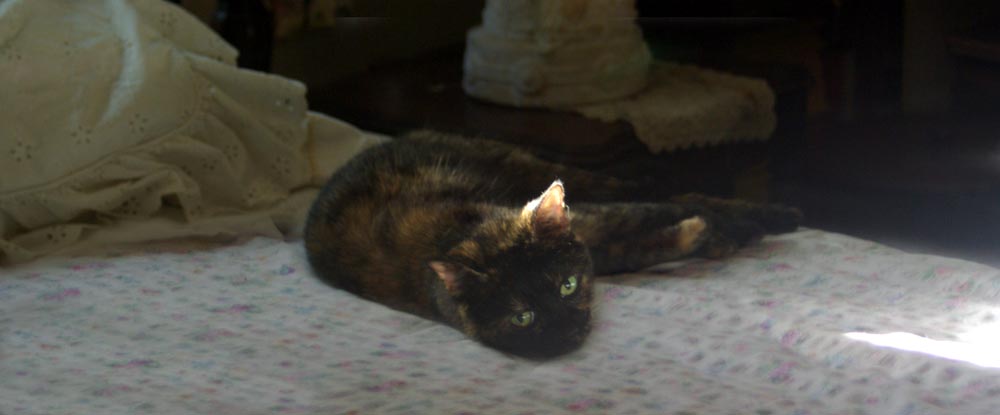
How easily can a cat go into heat stroke? More easily than I thought as I discovered with Kelly during the recent heat wave. Sometimes, even with the best of intentions, the situation can get out of control with a series of circumstances so with all pets, and especially those who might be on the edge with health, it’s best not to presume everything is okay.
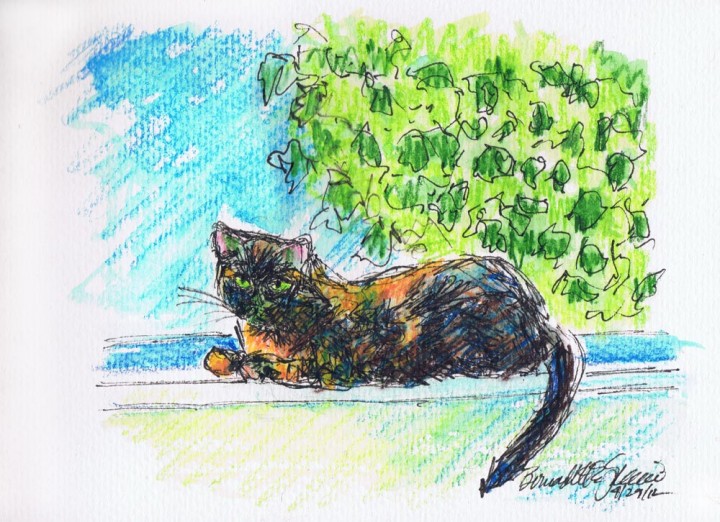
Cats and heat stroke
Cats don’t suffer from heat stroke as easily as dogs because they just aren’t as active in hot weather, going out for walks and play, exerting themselves in the heat. But even if a cat never goes outdoors, the indoors can still get pretty darned hot. Not everyone has air conditioning—I’m one of those—and even with it many people turn the thermostat up during the day when they are away to conserve energy but leave the windows shut, and the temperature can easily hit 90 indoors on a hot sunny day. They need to be able to get to a cooler place, even a tile or hardwood floor or a basement.
All animals enjoy lolling in a sun puddle, especially cats, and on a hot day can actually put themselves in danger simply by sleeping on a sunny windowsill.
And a smaller room can get very hot very fast with the door closed, even sometimes with air conditioning.
Symptoms of heat stroke in pets
Just like humans, at greatest risk are the ill, the very young and very old, and obese animals and breeds with short noses.
The most easily-observable symptoms of heat stroke begin with restlessness and excessive, continued panting, which may be hard to tell in dogs but it is extremely un-catlike, so this should tip off a cat owner right away. Other symptoms you can easily observe are drooling, then vomiting and diarrhea, bright red or purple lips and gums, possible seizures and small hemorrhages that look like bruises on the skin. In the meantime the animal is going from restless to lethargic to possibly comatose. Even at the very beginning of the symptoms, the condition is life-threatening and needs treatment immediately.
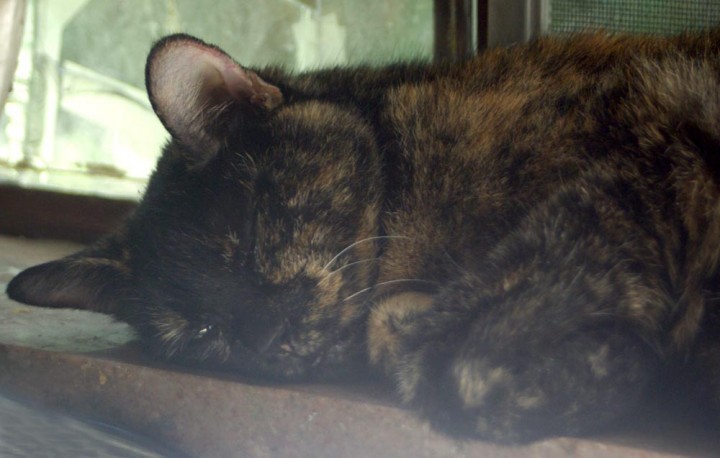
What happened to Kelly?
Bear in mind, I’ve lived in this house, with cats, for 22 years, and we have had some extreme temperatures in those two decades.
I don’t have air conditioning, but can keep my house fairly comfortable with fans and open windows and blinds to block the sun and a series of very large trees, and that serves to keep the house interior no warmer than 85 degrees, even when the temperatures begin to rise into the 90s.
Temperatures do rise above 90 degrees here in Western Pennsylvania, but they rarely stay there for a week or more. When the string of days above 90 degrees, even above 95 and approaching 100, and night-time temperatures of 80 or higher, stretches for seven days or more, no trees or fans or curtains will keep the air cool. Everything simply absorbs the heat and has no chance to cool down, and that includes us—and our cats.
While Kelly may still look and seem quite agile and healthy, she is 19 years old, at an age when I observe her diet and habits closely every day. Kelly is actually in very good shape for her age, still able to run up and down steps and leap tall dressers in a single bound, but even though she drinks from her water bowls every day she doesn’t drink enough to keep herself hydrated as she should. I add water to her food and I always keep an eye on her hydration, checking her skin for flexibility and her gums for proper moisture, and always keep an eye on her appetite and what goes into the litterbox. If I notice she seems a little dehydrated, with the instruction, materials and order from her veterinarian, I keep a bag of sub-cutaneous fluids on hand and give her a sustaining dose between 50cc and 100cc perhaps three times per month.
Normally Kelly is the timekeeper for meals and takes her place in anticipation, eating everything in her bowl and sometimes nudging into someone else’s. I had noticed she wasn’t quite finishing her meals and took note of it. In the heat she was, like all the younger cats, more lethargic than usual, which also meant she wasn’t visiting the water bowl as often as usual, and perhaps she wasn’t eating as much because of the heat; the younger ones were eating less as well.
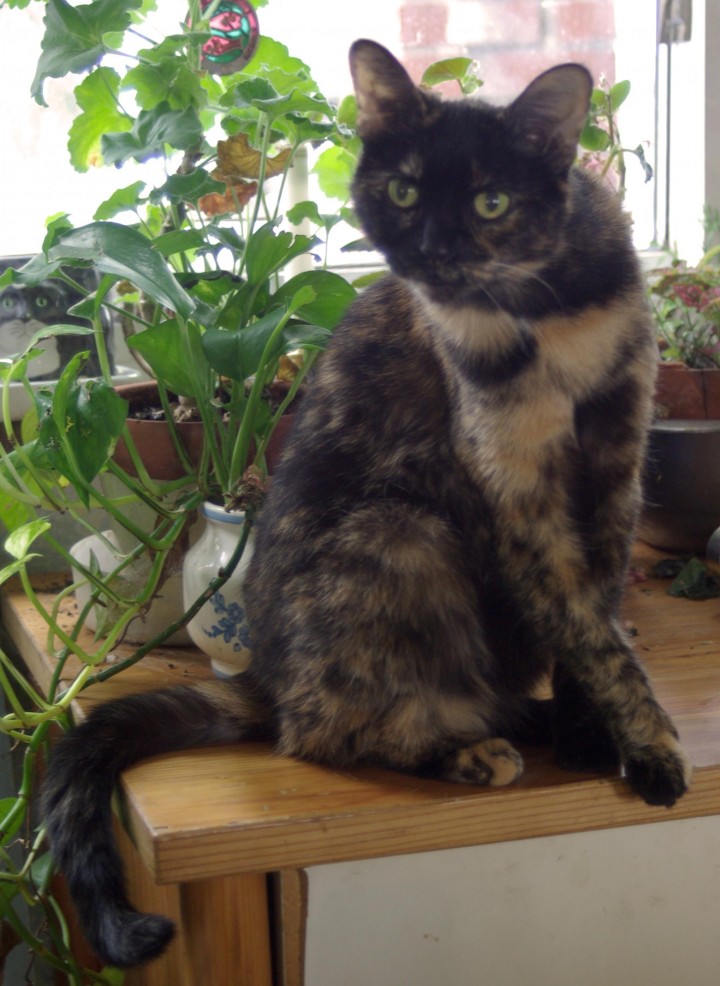
I feed my cats twice daily, but when any of my cats has reached their late teens they often need a little extra meal because, like most seniors, they simply eat less at each meal, and they appreciate easier access to a water bowl and litterbox, and a break during the day. I call this the Senior Kitty Lunch Special, and Kelly has been enjoying this daily regimen every afternoon for over a year, spending time in the bathroom on her favorite windowsill after her lunch.
On a day that was to reach 96, I had decided she should have a dose of fluids that day. I hesitate to let Kelly in the basement after the day I found her tucked quietly in the base of my chest freezer, not answering my calls, so she couldn’t take refuge in the basement with its cool concrete floor. I could tell her hydration was only starting to decline, but with the heat forecast to continue and increase I thought I’d head off a bad situation for Kelly and give her a dose of fluids that morning, especially when she didn’t eat her breakfast.
But I discovered I didn’t have an extra bag of fluids on hand as I thought I did, and her regular vet was out of town so it would take me some time to get another. I took her and her breakfast and some ice cubes for her water and a fan to the bathroom, which is unfortunately warmer in the morning, darkened the window and saw her drink from her bowl on the windowsill and start eating. About 20 minutes later I checked on her and she’d used the litter box for both movements and eaten her breakfast so I let her out, but when she ran into my studio she was panting, really panting. She left there and went into my bedroom, still panting off and on.
Cats don’t pant unless they are in distress, and Kelly was clearly in distress. I had watched long enough to see that it wasn’t a temporary problem just from exertion as the panting abated a bit but not completely. I remembered from my Pet First Aid training the symptoms of heat stroke—mainly restlessness and panting—tried unsuccessfully to take her temperature and just start to cool her down rather than stress her out even more.
Between the internet and finally finding my Pet First Aid handbook (NOTE: keep it handy!) I read about where in the process she would be and what to do and decided that trying to cool Kelly down a bit before tossing her in a hot car would be the best next move. Cold water on the paws, cold towels around their body, a bag of frozen vegetables or ice wrapped in a towel as a compress on their neck or torso was described. I didn’t have anything that would suffice as a cold compress except for ice, my tap water wasn’t terribly cold, and I thought that with what I had on hand knew Kelly needed more than a little bit here and there, she needed total cooling, right now.
I brought one of my big enamel bowls from the basement and filled it with water that just felt cool to my hand, got a bigger fan and Kelly and settled her into the water with the fan blowing on her and me. No, cats don’t like water and Kelly is easily frightened and put up a fuss. The last thing I wanted to do was distress her even more, but even though she struggled the water was only halfway up her torso when sitting and I could tell after her initial fear in just a few seconds it felt soothing. She stopped panting in less than a minute and let me dipper water over all of her that was above the level except for her head. I kept her in there for about 10 minutes, then let her out into the tub with the fan directed on her so she could get herself together and eventually start to dry herself.
I had contacted another veterinarian about getting a bag of fluids and also described Kelly’s symptoms, not certain if she still needed to be seen after her incident. Her temperature after her immersion was 102.3. A cat’s normal temperature averages right around 101, but can be up to 102.5 normally. I know Kelly’s is normally near 102, so that was elevated for her but not at a dangerous level; any elevated temperature should be carefully monitored, and while 103 is the beginning of the danger zone a temperature of 105 or 106 can be lethal, so even tenths of a degree count. While I made arrangements for her fluids I asked if she needed to see the vet—the risk of taking her out on such a hot day was great on its own. She was not panting and her temperature was near normal so we decided just to observe her, use compresses or another cool dip to help bring down her temperature and give her the fluids. After that and a little relaxing drying session, she was back down to 101.8 and seemed to feel much better.
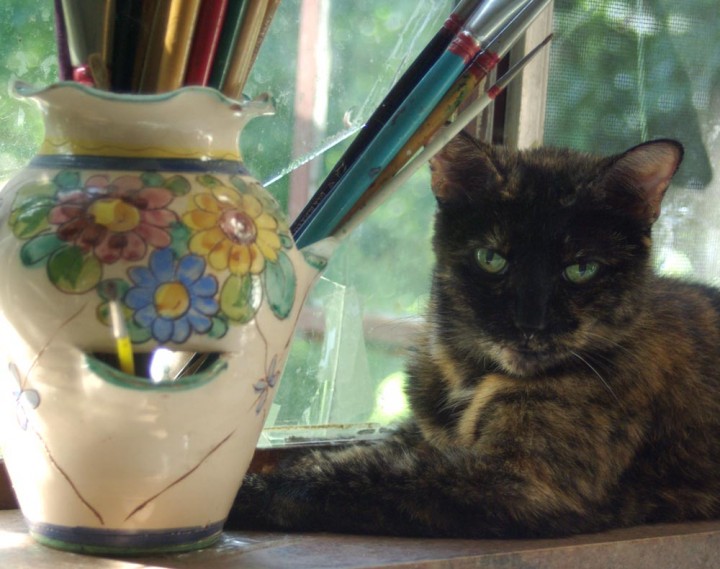
I ran out to get the fluids and gave her a 100cc dose that day. But as the heat continued I knew she wasn’t drinking enough so I gave her 100cc fluids daily for four days in a row and then a few other doses, as the extreme heat lasted a total of ten days. The temperatures cooled for about a week then grew hot again and this time I made certain I had enough fluids on hand, gave her a dose at the beginning of the high temperatures and again at the end, and she had no more need for dunkings but I did closely watch her and she had to suffer the indignity of a temperature check on hot days when she seemed particularly lethargic.
Wrapping it up
When something like this happens I am always concerned it will happen again, especially since Kelly’s hydration is an ongoing problem and this promises to be a long, hot summer. I talked with Kelly’s veterinarian about this and she gave me even more tips about how to easily cool an animal down when it gets over heated, such as filling a plastic bottle with cool water and laying it between their legs against the belly, since the inner torso is the hottest area. She also mentioned using rubbing alcohol on the paws because it will help them cool as it evaporates; in dire circumstances you can use it on their torso as well, though it has to be rinsed off. Kelly’s condition seemed to be brought about by the hot bathroom as she warned that bathrooms can get hot really fast when the door is closed. Because I have been observing Kelly’s health under her instruction for a while now, as well as all my other cats, I am familiar with Kelly’s heart function, confident it was normal enough to withstand this treatment. And most important, Kelly knows and trusts me and even with her fear of the water and confusion in her condition, we have a bond that helped her to trust that I was doing the right thing.
Be observant and proactive
So even with careful observation, a combination of mild dehydration in the heat, topped off with excessive heat in the bathroom for that brief time, led to mild heat stroke in geriatric Kelly. I’m just glad I was home and could act quickly, and having achieved certification in Pet First Aid, I had a background of information and instructions to reference as the situation developed and veterinarians to call for guidance.
Reference sites:
http://cats.about.com/b/2006/06/15/help-your-cat-beat-the-heat.htm
All images used on this site are copyrighted to Bernadette E. Kazmarski unless otherwise noted and may not be used without my written permission. Please ask if you are interested in purchasing one as a print, or to use in a print or internet publication.


Pingback: Daily Photo: Dreamy Little Girl - The Creative Cat
Pingback: Extra Hydration in Summer Heat for Pets, Wildlife and People ~ The Creative Cat
Pingback: The Creative Cat - Beat the Heat With Water for Pets, Wildlife—and People
Pingback: The Creative Cat - The Artist’s Life: Selling Paintings of My Cats
Pingback: The Creative Cat - Where’er You Walk
Pingback: Points to look for when Preparing for Adopting a Cat
Pingback: Your Questions About Senior Cats Vomiting
Thank you so much for this story. My human really appreciated reading it. It is so very important to know AHEAD of time, before it happens.
Kelly is really a beauty too!
Purrs
Texas, I thought I had everything under control but I guess I was wrong! It is good to know this in advance, you just never know when conditions will convene like this. And Kelly is like a little elf.
Glad to hear that Kelly made it through this crisis OK, Bernadette — and glad I now know what to do for my own guys should such an emergency arise. Like Vicki, I knew about doing the frozen-bottle thing for bunnies: it never occurred to me that you could do that for cats, too. And I’d say that your emergency first-aid solution was damned impressive.
Tammy, thanks! I was shocked it even happened, and that’s why I wanted to share it–I thought I had Kelly’s condition taken care of and I’m really glad I had an idea what to do.
Your cats are fortunate that you are so attuned to their needs. I’m glad Kelly is okay.
I worry about Mewdy Blue myself. He is 15 now and has always been heat-intolerant. When he was very young he fainted twice at a cat show because of the heat and was diagnosed with hypertrophic cardiomyopathy. His heart is fine now but he still can’t handle the heat.
Ironically he refuses to stay downstairs where I do have air conditioning. Instead he spends too much time upstairs where it is horrible! This week we are supposed to have at least 4 days in a row of triple digit temps so I’m going to be watching him closely.
Thanks so much for the many ideas!
Andrea, that sounds pretty serious! My Namir did have HCM and I tried to get him to stay in the basement where it was cooler, but he would have none of that, he wanted to make sure he was at the door if visitors came. I’m glad the ideas helped you, and I hope Mewdy Blue stays well!
Oh My COd!! Miss B…this is so furry impawtant!! People mostly talk about their dogs and the heat..but cats are so stressed by it too, especially our Seniors like my heroine Miss Kelly…how is Miss COcoa if I may ask??
Anyway, My Mom is ON THIS ONE…she is Tweeting it, sharing on her’s and my Face Book pages and we will save it to blog about too. You are pawsome!!!
Savannah, tell your mom thanks, and I’m glad it helped her and hope it helps many more. Kelly has been fine since her incident, though I need to give her fluids at least once each week now, just because of the heat.
Very interesting information, and so glad Kelly’s okay. Hadn’t thought of filling up and freezing water bottles….
Lisa, it looks like we should all keep a few frozen water bottles on hand from now on. I certainly will!
Bernadette – when it gets this hot, bunny people fill up 2-liter bottles with water and freeze them so the bunnies can lay beside them to cool off. Maybe you could try that with Kelly. Also a large ceramic tile would give her a cool place to lay. Good luck and stay cool!
Vicki, ironically enough, I keep frozen two-liters in my chest freezer over the summer because it’s nearly empty until harvest time in late summer and it runs more efficiently when it’s more than half full. The ice bottles also come in handy when I want to cool water fast, either for my feet on a hot day, or when I’m blanching vegetables and need to dunk them in really cold water. However, do you remember Kelly’s incident crawling into the base of the chest freezer a few weeks ago? I had to unplug it to pull it out and look in the back, then decided to clean it and leave it unplugged until I needed it later this summer, so no frozen water bottles either, and I couldn’t make ice fast enough, no frozen vegetables, I was really out of everything!
Wow… thank goodness you are so atuned to your cats needs. Because we live in Florida and have air conditioning, we normally don’t have this problem. But, when we lose power due to hurricanes or tropical storms, the temperature can get dangerous, quick. Thank you for sharing this information, and especially for sharing Kelly’s story. Senior cats do have different needs and I am grateful you were able to help her.
Deb, you’re right about the power outages, even if you have air conditioning, and people often turn it up during the day and it gets hotter than they realize. If I could have trusted Kelly in the basement she would have been okay, but she got herself lost down there a few weeks ago…and the chest freezer with the big frozen containers of water was unplugged. So much for preparation! And after nearly a dozen geriatric cats I’ve gotten pretty wise to their ways.